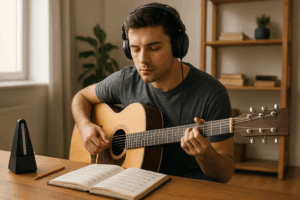Learning how to read sheet music can feel like learning a new language — and in many ways, it is. But just like any language, once you get familiar with the basics, a whole world of possibilities opens up. Whether you’re picking up a guitar, sitting at a piano, or preparing to sing, knowing how to read music will deepen your musical understanding and enhance your ability to perform. In this guide, we’ll break it down step-by-step for beginners so that you can start reading music with confidence.
What Is Sheet Music?
Sheet music is a written representation of musical notes and rhythms. It tells you what notes to play, how long to hold them, and when to play them. It’s used by musicians to perform pieces accurately, especially in classical, orchestral, or educational settings.
Sheet music is typically written on a staff — a set of five horizontal lines where notes are placed. The position of the note on the staff and the symbol used determine what sound should be played.
The Musical Staff and Clefs
The first thing you’ll notice on any piece of sheet music is the staff, which has five lines and four spaces. Each line and space represents a different musical pitch.
There are two main types of clefs used in beginner sheet music:
- Treble Clef (G Clef): Commonly used for higher-pitched instruments like the violin, flute, trumpet, and also for the right hand in piano.
- Bass Clef (F Clef): Used for lower-pitched instruments like the cello, bass guitar, tuba, and the left hand in piano.
Each clef determines the name of the notes on the staff.
Notes on the Treble Clef
- Lines (bottom to top): E – G – B – D – F
(Tip: “Every Good Boy Does Fine”) - Spaces (bottom to top): F – A – C – E
(Easy to remember — it spells “FACE”)
Notes on the Bass Clef
- Lines (bottom to top): G – B – D – F – A
(“Good Boys Do Fine Always”) - Spaces (bottom to top): A – C – E – G
(“All Cows Eat Grass”)
Understanding Note Values
Each note has a shape that tells you how long to hold the sound. Here’s a basic breakdown:
- Whole Note (𝅝): 4 beats
- Half Note (𝅗𝅥): 2 beats
- Quarter Note (♩): 1 beat
- Eighth Note (♪): 1/2 beat
- Sixteenth Note (♬): 1/4 beat
You’ll also see rests, which indicate silence. Rests have their own symbols and durations (whole rest, half rest, etc.).
Time Signatures and Measures
Music is divided into measures (or bars), which help organize rhythm. The time signature tells you how many beats are in each measure and what kind of note gets one beat.
For example:
- 4/4 time (common time): 4 beats per measure; a quarter note gets one beat
- 3/4 time: 3 beats per measure; often used in waltzes
- 6/8 time: 6 beats per measure, but grouped in 2 strong beats
Note Placement and Pitch
Notes placed higher on the staff are higher in pitch, and those lower on the staff are lower in pitch. If a note goes above or below the staff, ledger lines are used.
For example, Middle C (the C near the center of a piano keyboard) is written on a ledger line below the treble staff or above the bass staff, depending on context.
Key Signatures and Sharps/Flats
A key signature appears at the beginning of a staff, right after the clef, and tells you which notes are consistently sharp (♯) or flat (♭) throughout the piece. This gives the piece its tonal center, or key (like C major, G minor, etc.).
If a note needs to be sharp or flat just for one measure, you’ll see a sharp (♯) or flat (♭) symbol placed before the note — called an accidental.
Dynamics and Expression
Sheet music doesn’t just tell you what to play — it also tells you how to play. Here are some basic dynamics:
- p (piano): play softly
- f (forte): play loudly
- mf (mezzo-forte): moderately loud
- crescendo (<): gradually get louder
- diminuendo (>): gradually get softer
You may also see terms like legato (smooth), staccato (short and detached), or ritardando (gradually slowing down).
Basic Tips for Beginners
1. Start Simple
Use beginner sheet music with basic rhythms and a limited range of notes. Don’t jump into complex pieces right away.
2. Use Mnemonics
Remember the note names using the mnemonics mentioned earlier. They’re surprisingly effective.
3. Practice Identifying Notes
Flashcards or apps like Tenuto or MusicNotes can help reinforce note recognition.
4. Learn the Piano Keyboard
Even if you’re not learning piano, visualizing where notes are on a keyboard helps reinforce your reading.
5. Count Aloud
When learning rhythms, count beats aloud (1-2-3-4) to internalize timing.
6. Combine Reading and Playing
Practice playing simple pieces as you read them. Reading should be linked with sound and action.
Why Reading Music Matters
You might wonder: can’t I just play by ear or watch tutorials? While many musicians do learn that way, reading music gives you access to any piece ever written — from Bach to pop. It also makes it easier to communicate with other musicians, join bands or ensembles, and progress to more advanced material.
Final Thoughts: Turning Symbols Into Sound
Reading sheet music might seem overwhelming at first, but it becomes second nature with regular practice. Start with the basics, don’t rush, and celebrate small victories. Whether your dream is to play in a band, compose your own songs, or just enjoy playing for fun, learning to read music will open doors you never knew existed.




